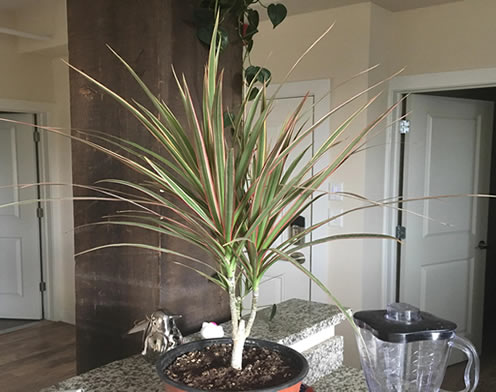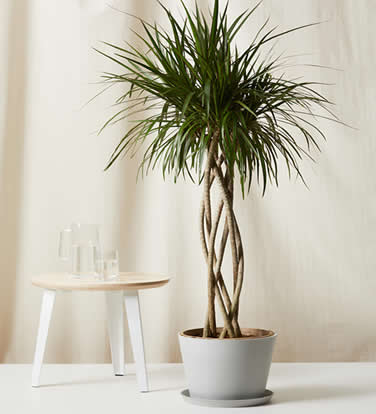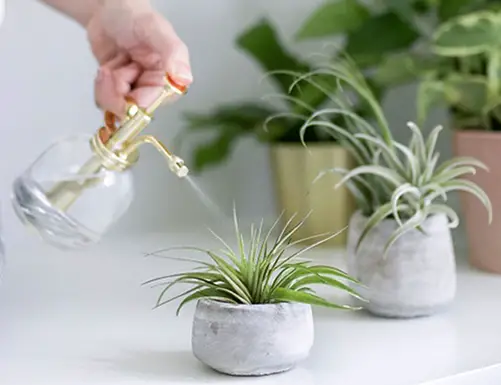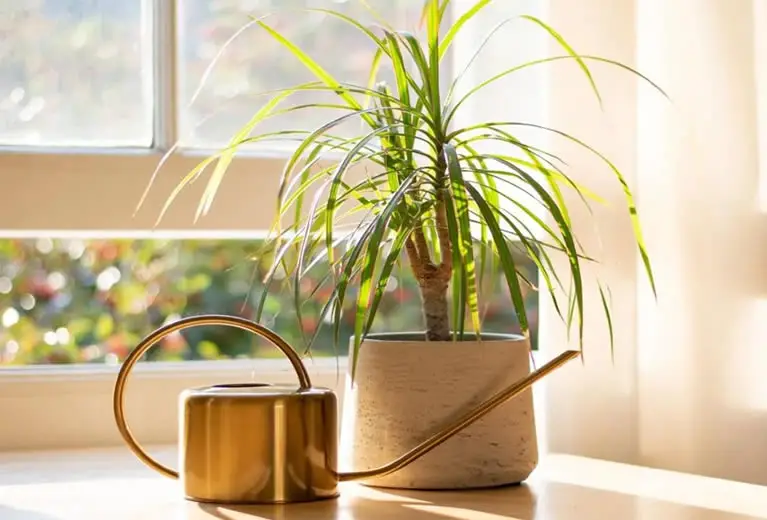A dracaena palm is a very popular houseplant, and in some areas it is even cultivated as a garden tree, but it is not like most other popular plants. As succulents, all dracaena have very specific watering requirements that differ greatly from non-succulents. A dracaena palm is no different.
Table of Contents
- Dracaena Palm Watering Needs
Dracaena Palm Watering Needs
Get your watering schedule wrong and it could be disastrous for your plant.
So in this article I will outline how to, and how often you should, water your dracaena palm.
How often you should water your dracaena palm
So how often does a dracaena palm need watering?
A dracaena palm requires watering only when the top 1 ½ inches of soil dries out. For an average dracaena palm houseplant this will be once every 2 – 3 weeks though it is better to test the soil for moistness rather than rely on a set schedule.
Dracaena plants are part of a genus of about 120 species of tropical succulent shrubs and trees. The dracaena palm is a succulent tree.
The Dracaena Palm, Dracaena Marginata, is also known as the Dragon Tree (along with the Dracaena Draco, Dracaena cinnabari, is also called a dragon tree) and the Madagascar Palm. But dracaena marginata isn’t actually a palm tree at all.
The dracaena palm is much closer to cactus than it is to a palm tree. Why is it important to make this distinction?
Well, a palm tree is an evergreen plant that requires frequent watering and a dracaena palm is a succulent that requires infrequent watering.
Incorrectly categorizing a dracaena marginata as a palm tree and giving it the type of care a palm tree requires will result in your dracaena dying.
Succulents require much less watering than palm trees and other evergreen houseplants, so you must not simply water your dracaena palm when you water your other indoor plants. Nor must you follow a watering schedule that is designed for a palm tree.

Only when the top layer of soil dries out should you water a dracaena palm.
How can you tell when the soil has dried out sufficiently for rehydration of the plant?
Although you can use the simple finger test I advise you use a cheap moisture meter to determine when the plant requires watering.
Never stick to a set schedule until you know the watering needs of your individual plant. Checking the soil for moisture before watering is much safer for your plant than just sticking to a set schedule. For instructions on how to use a moisture meter read the section below.
Why is getting the watering schedule vital for cultivating a healthy dracaena marginata palm?
All types of dracaena succulents, and this includes the dracaena palm, are highly susceptible to developing root rot when they are overwatered. Overwatering a succulent is something that is extremely easy to do because these plants are so drought-resistant and are not as heavily water-dependent as most other popular indoor and yard plants.
Root rot is extremely serious and will usually result in the loss of your plant. So it is very important you do not give a dracaena palm too much water. Hence, why I advise you to use a moisture meter instead of a set schedule.
Does this advice apply to all varieties of dracaena?
All dracaena plants are succulents and therefore require sparse watering. You should only water your dracaena when the top 1 ½ inches of soil dries out. On average a dracaena will need to be watered every 2 – 3 weeks.
All dracaena plants are succulents.
With over 120 different species of dracaena, there are both succulent shrubs (such as the lemon lime dracaena) and succulent trees (such as the dragon tree). Because they all belong to the same genus of plant they all require similar care. (See our guide how to root dracaena for this plant’s overall care needs and dracaena light requirements for where to place your dracaena succulent).
How to know if your dracaena needs water
I am often asked what signs to look for in order to tell when a dracaena plant requires watering. There is only one sign you should look for when it comes to watering a dracaena and it is in the soil.
You will know your dracaena needs water when the top layer of soil, to a depth of about 1 ½ inches, dries out. Do not wait to see signs of dehydration in the foliage, nor should you water the plant regularly. Only water it when the soil dries out.
I have come across many “experts” who claim that signs of dehydration are an indication that your dracaena needs to be watered. They tell you that wrinkled, dry leaves and even a drooping plant indicate that it’s time to water a dracaena.
Although signs of dehydration are indeed indications that the plant may need watered they could just as easily be signs that the plant has been overwatered (see our root rot guide linked to above for an explanation of why this is the case).
Even if the plant has been underwatered you should never wait this long before hydrating your dracaena! The soil will always tell you when the plant requires watering.
As I mentioned before use a moisture meter to determine when the soil is sufficiently dry to warrant watering the plant. A moisture meter will help eliminate the risk of overwatering.
How do you use a moisture meter with a dracaena palm or other dracaena plant?
It’s simple: push the meter prong down into the plant soil to a depth of about 1 ½ inches. Only water the dracaena when the meter reads “dry”. It really is that simple.
How to water your dracaena marginata palm the right way
Dracaena marginata, the dracaena palm, (and all other varieties of dracaena) is more than happy to be watered from the top or from the bottom.

Let’s take a look at how to water your dracaena palm from either the top or the bottom now.
How to water dracaena marginata from the top
Unlike a majority of succulents, dracaena marginata can be watered from the top.
Many succulents do not like water getting on their foliage but this is not a problem for a dracaena palm.
When watering your dracaena marginata from the top be sure that the top layer of soil is completely dry before watering (see the section above for information on why this is important).
You should water the plant generously ensuring the soil is completely wetted. Be sure not to drench the soil however, as dracaena marginata does not like to sit in standing water. You will therefore need to ensure any excess water is drained away from the soil or removed from any tray or saucer that you may be using underneath the plant.
Because it is possible to overwater a dracaena marginata when watering it from the top – as water may accumulate in a saucer or tray or may just not have an opportunity to drain away effectively – I prefer to water all dracaena plants from the bottom. Obviously this is not possible when you have a dracaena marginata growing directly in garden soil, so just be careful not to drench the soil when watering a outdoor yard plant.
How to water dracaena marginata from the bottom
Watering dracaena marginata from the bottom is a very easy process and in my opinion a much better way of hydrating the plant simply because it is easier to ensure all excess water is drained away from the plant once the watering process has been completed.
Begin by placing the dracaena marginata, still potted, into a sink that is filled with just enough water to reach midway up the sides of the pot.
Never put so much water into the sink that it spills over the sides of the pot and flows directly into the soil, as this will drench the soil in water resulting in an overwatering of the plant – as I addressed above this can be disastrous for your succulent.
Leave the plant in the water for roughly 15 minutes but no longer than 20 minutes.
After removing the dracaena palm from the water, and before replacing the plant back in its permanent location, place it somewhere where all the excess water can drain out of the pot.
Of course many dracaena plant owners will choose to use a self-watering pot, which is perfectly fine, though you must ensure you know how to use it properly as simply adding water to it regularly can result in an overwatering of your dracaena.
You can also mist your dracaena – here’s how often you should do it
Although misting a dracaena is not completely necessary it can be beneficial to a dracaena houseplant.
You should mist a dracaena houseplant 1 – 2 times per week. Misting can help keep the foliage hydrated especially in very dry climates or in the winter when home heating dries the air.
As dracaena like an environment with the type of high humidity that mimics the plant’s native tropical rainforest, misting can also help raise humidity levels directly around the plant.

However, the increase in humidity from misting is nominal and short-lived so I advise you to use a much more efficient plant humidifier for this purpose. As you only need to raise the humidity directly around the plant and not in the entire room, a cheap plant humidifier with a short range is all that is required.
It is fine to use tap water to hydrate a dracaena – in most locations!
What type of water should you use on a dracaena palm and other dracaena species of plant?
It is perfectly fine to water dracaena with tap water though in some areas that have “hard water” this may result in brown tips developing on the plant. These brown tips can be pruned off the plant though using purified water will completely eliminate this problem.
In many areas, especially in the United States, tap water contains elements that are not beneficial to many houseplants. The levels of fluoride and sodium in the tap water of many areas can result in a dracaena plant developing brown tips on its leaves.
Although you can easily snip away the brown tips it is far from the ideal way to deal with the problem.
Pruning, although beneficial for helping make a dracaena bushier, can detract from the overall look of your plant. A better solution is to take steps to avoid brown tips developing in the first place. How do you do this?
Watering a dracaena with purified water will eliminate the chance of the plant developing brown tips on its leaves.
If you do not have a water purifier in your home and rely on purchased bottled purified water then you will want to water the plant from the top for cost reasons.
Having said that, water purifiers are fairly cheap even the type that fit on a kitchen tap so using a purifier that removes chemicals from the water directly at the tap means you can still water your dracaena from the bottom.

